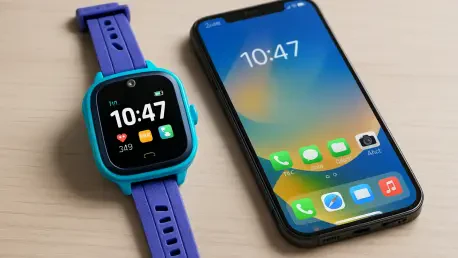In an era where technology permeates every aspect of daily life, a staggering number of parents grapple with the challenge of keeping their children safe while allowing them to explore the digital world—reports suggest over 60% of kids aged 8 to 12 now use connected devices regularly, highlighting the urgency of this issue. This growing trend has spurred the development of child-specific gadgets, with smartwatches and smartphones emerging as primary tools tailored to young users. These devices cater to distinct needs, balancing connectivity with parental oversight in a landscape filled with both opportunity and risk.
Smartwatches, often designed for younger children, serve primarily as safety and communication tools, offering features like location tracking and emergency contact options. Smartphones, on the other hand, target older kids with broader functionality, providing access to apps and internet capabilities under controlled conditions. Both address critical parental concerns such as safety, digital wellness, and staying connected in a tech-driven society, making them indispensable for many families navigating modern challenges.
A notable example of this trend comes from TCL, with its Movetime MT48 smartwatch and Nxtpaper 5G Junior smartphone. These devices exemplify age-appropriate solutions, with the smartwatch focusing on essential safety for younger users and the smartphone offering more advanced features for tweens and teens. This comparison delves into how such technologies meet varying needs, setting the stage for an in-depth analysis of their roles in children’s lives.
Key Comparisons Between Smartwatches and Smartphones for Kids
Safety Features and Parental Control
Safety remains a top priority for parents when choosing tech for their children, and both smartwatches and smartphones offer distinct mechanisms to address this concern. Devices like the Movetime MT48 smartwatch are equipped with advanced Dual Frequency GPS for precise location tracking, an SOS button for emergencies, and 4G calling capabilities, ensuring immediate access to help. Its IP68 durability rating also means it can withstand the rough-and-tumble nature of young kids’ activities, providing peace of mind in unpredictable situations.
In contrast, smartphones such as the Nxtpaper 5G Junior focus on comprehensive oversight through integrated parental controls, allowing restrictions on app usage and screen time. While location tracking is often available, the emphasis shifts toward managing digital behavior rather than physical safety alone. This makes smartphones more suitable for older children who may not need constant real-time monitoring but still require boundaries in their online interactions.
The difference in safety focus is clear: smartwatches prioritize immediate, location-based security for younger users who need constant supervision, while smartphones offer tools for broader behavioral management as kids grow more independent. Each approach reflects a tailored response to the evolving needs of children at different stages, ensuring that safety adapts to age and maturity.
Functionality and Age Appropriateness
When it comes to functionality, smartwatches and smartphones cater to vastly different levels of digital engagement based on a child’s age. The Movetime MT48, for instance, offers limited but purposeful features such as basic communication and minimal screen interaction, designed to prevent overexposure to technology. This simplicity aligns with the needs of younger children who require connectivity without the distractions of a full-fledged device.
Smartphones like the Nxtpaper 5G Junior, however, come packed with expansive capabilities, including 5G connectivity, a 50MP camera, and expandable storage up to 2TB. These features support older kids who are ready for more digital independence, whether for schoolwork, social interaction, or creative expression. The trade-off is a higher potential for distraction, necessitating stricter parental oversight to manage usage effectively.
TCL’s segmentation strategy highlights this developmental alignment, positioning the Movetime MT48 for younger kids under 10 and the Nxtpaper 5G Junior for tweens and teens. This distinction ensures that each device matches the user’s maturity, balancing the need for basic tools with the demand for more complex functionality as children grow and their requirements evolve.
Wellness and Health Considerations
Digital wellness is another critical factor in evaluating tech for kids, as excessive screen time can impact physical and mental health. Smartwatches inherently limit this risk by design, with small screens and focused features that discourage prolonged use. The Movetime MT48, for example, encourages minimal interaction, reducing the chance of eye strain or digital fatigue among young users.
Smartphones, while offering larger screens for extended engagement, often incorporate health-focused innovations to mitigate risks. The Nxtpaper 5G Junior features a 6.67-inch display with eye-comfort technology that cuts down on glare and blue light exposure, addressing concerns about vision health during longer sessions. Despite these advancements, the potential for overuse remains a challenge if not monitored closely.
Balancing these wellness aspects reveals a key contrast: smartwatches naturally curb overexposure through limited interfaces, while smartphones rely on technological safeguards and parental intervention to manage health risks. Both approaches aim to protect young users, but their effectiveness depends on how well families integrate usage guidelines into daily routines.
Challenges and Limitations of Each Device
Smartwatches, while excellent for safety, come with notable drawbacks that may not suit every child. Their limited functionality can become restrictive as kids grow older and require more digital tools for learning or socializing. Additionally, their effectiveness often hinges on proper parental setup, which can be a barrier for less tech-savvy caregivers unfamiliar with configuring such devices.
Smartphones present their own set of challenges, particularly the risk of overuse and exposure to inappropriate content, even with robust controls in place. The higher cost—such as the Nxtpaper 5G Junior priced at $290 compared to the Movetime MT48 at $175—can also be a deterrent for budget-conscious families. Furthermore, the complexity of managing a smartphone’s features may overwhelm younger teens or parents not fully equipped to enforce digital boundaries.
Common concerns across both devices include battery life under heavy child use, durability against rough handling, and ethical debates surrounding constant monitoring or tracking of a child’s activities. These issues underscore the importance of parental education in navigating technology’s role in family life, ensuring that potential risks are mitigated through informed decision-making and consistent dialogue about responsible usage.
Conclusion: Choosing the Right Device for Your Child
Looking back, the comparison between smartwatches and smartphones for kids revealed stark differences in their strengths: smartwatches like the Movetime MT48 stood out for their simplicity and safety focus for younger children, while smartphones such as the Nxtpaper 5G Junior provided versatility and controlled independence for older ones. Each device carved a niche based on developmental needs, offering tailored solutions to modern parenting challenges.
For families moving forward, a practical next step involves assessing a child’s age and specific requirements—opt for a smartwatch for those under 10 needing basic connectivity, and consider a smartphone for tweens ready for broader digital access with oversight. Exploring resources on digital literacy could further empower parents to set boundaries and foster healthy tech habits.
Ultimately, aligning the choice of device with family values, budget constraints, and a child’s maturity proved essential in past decisions. TCL’s affordable and practical approach emerged as a reliable option, but the journey ahead should focus on ongoing conversations about technology’s impact, ensuring it remains a tool for growth rather than a source of concern.









